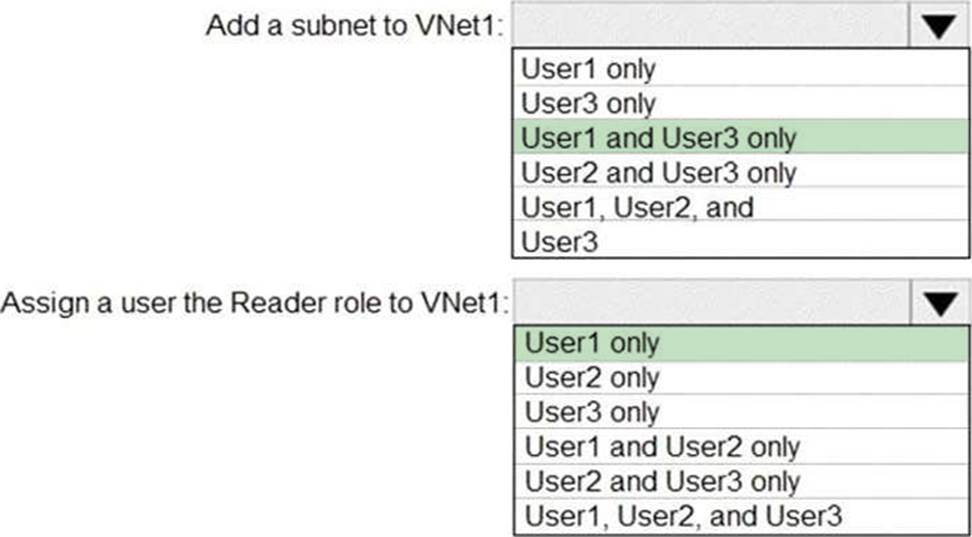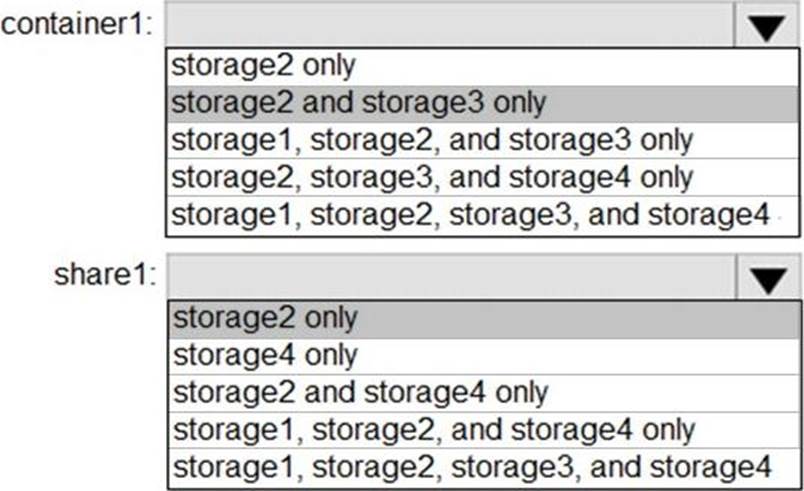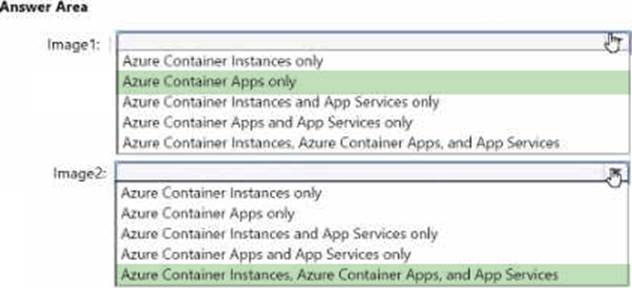Microsoft AZ-104 Real Exam Questions
The questions for AZ-104 were last updated at Nov 10,2025.
- Exam Code: AZ-104
- Exam Name: Microsoft Azure Administrator
- Certification Provider: Microsoft
- Latest update: Nov 10,2025
You plan to move a distributed on-premises app named App1 to an Azure subscription.
After the planned move, App1 will be hosted on several Azure virtual machines.
You need to ensure that App1 always runs on at least eight virtual machines during planned Azure maintenance.
What should you create?
- A . one virtual machine scale set that has 10 virtual machines instances
- B . one Availability Set that has three fault domains and one update domain
- C . one Availability Set that has 10 update domains and one fault domain
- D . one virtual machine scale set that has 12 virtual machines instances
HOTSPOT
You have Azure subscriptions named Subscription1 and Subscription2.
Subscription1 has following resource groups:

RG1 includes a web app named App1 in the West Europe location.
Subscription2 contains the following resource groups:

For each of the following statements, select Yes if the statement is true. Otherwise, select No. NOTE: Each correct selection is worth one point.
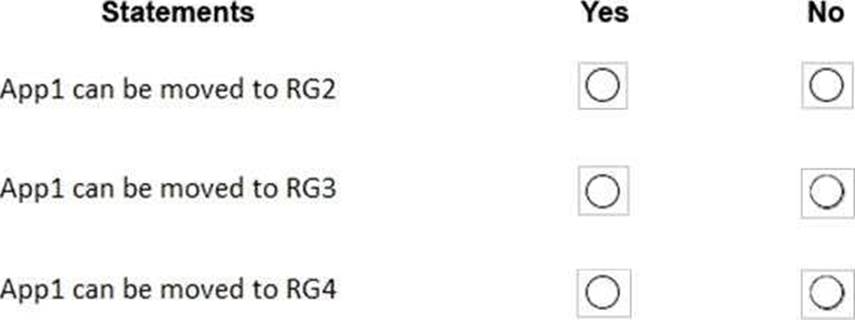
HOTSPOT
You have an Azure subscription named Subscription1 that contains a virtual network named VNet1.
You add the users in the following table.

Which user can perform each configuration? To answer select the appropriate options in the answer area. NOTE: Each correct selection is worth one point.
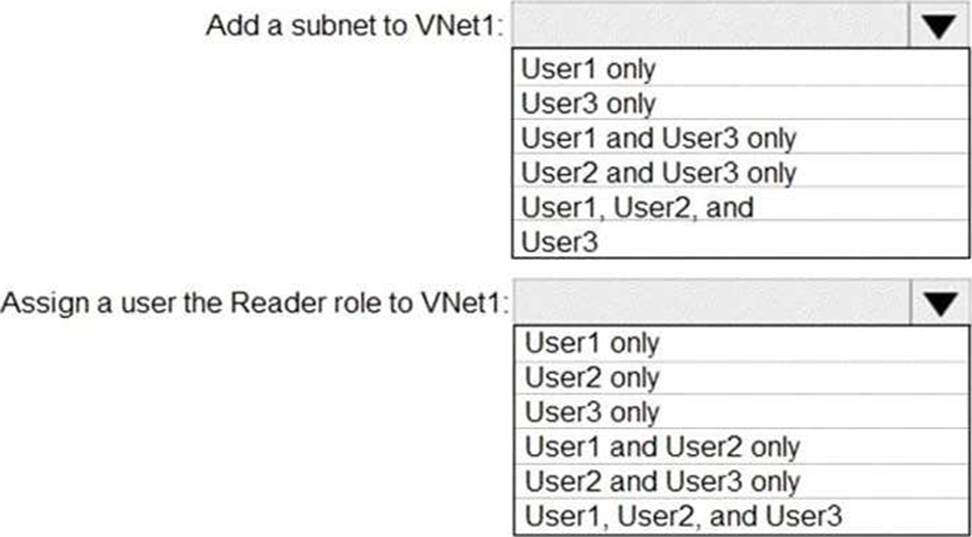
HOTSPOT
You have an Azure subscription that contains the resources shown in the following table.

You plan to create a data collection rule named DCRI in Azure Monitor.
Which resources can you set as data sources in DCRI, and which resources can you set as destinations in DCRI? To answer, select the appropriate options in the answer area. NOTE: Each correct selection is worth one point.

You need to prepare the environment to meet the authentication requirements.
Which two actions should you perform? Each correct answer presents part of the solution.
NOTE Each correct selection is worth one point.
- A . Azure Active Directory (AD) Identity Protection and an Azure policy
- B . a Recovery Services vault and a backup policy
- C . an Azure Key Vault and an access policy
- D . an Azure Storage account and an access policy
Topic 4, Contoso Ltd (Consulting Company)
Case study
This is a case study. Case studies are not timed separately. You can use as much exam time as you would like to complete each case. However, there may be additional case studies and sections on this exam. You must manage your time to ensure that you are able to complete all questions included on this exam in the time provided.
To answer the questions included in a case study, you will need to reference information that is provided in the case study. Case studies might contain exhibits and other resources that provide more information about the scenario that is described in the case study. Each question is independent of the other questions in this case study.
At the end of this case study, a review screen will appear. This screen allows you to review your answers and to make changes before you move to the next section of the exam. After you begin a new section, you cannot return to this section.
To start the case study
To display the first question in this case study, click the Next button. Use the buttons in the left pane to explore the content of the case study before you answer the questions. Clicking these buttons displays information such as business requirements, existing environment, and problem statements. If the case study has an All Information tab, note that the information displayed is identical to the information displayed on the subsequent tabs. When you are ready to answer a question, click the Question button to return to the question.
Overview
General Overview
Contoso, Ltd. is a consulting company that has a main office in Montreal and branch offices in Seattle and New York.
Environment
Existing Environment
Contoso has an Azure subscription named Sub1 that is linked to an Azure Active Directory (Azure AD) tenant. The network contains an on-premises Active Directory domain that syncs to the Azure AD tenant.
The Azure AD tenant contains the users shown in the following table.

Sub1 contains two resource groups named RG1 and RG2 and the virtual networks shown in the following table.

User1 manages the resources in RG1. User4 manages the resources in RG2.
Sub1 contains virtual machines that run Windows Server 2019 as shown in the following table

No network security groups (NSGs) are associated to the network interfaces or the subnets.
Sub1 contains the storage accounts shown in the following table.
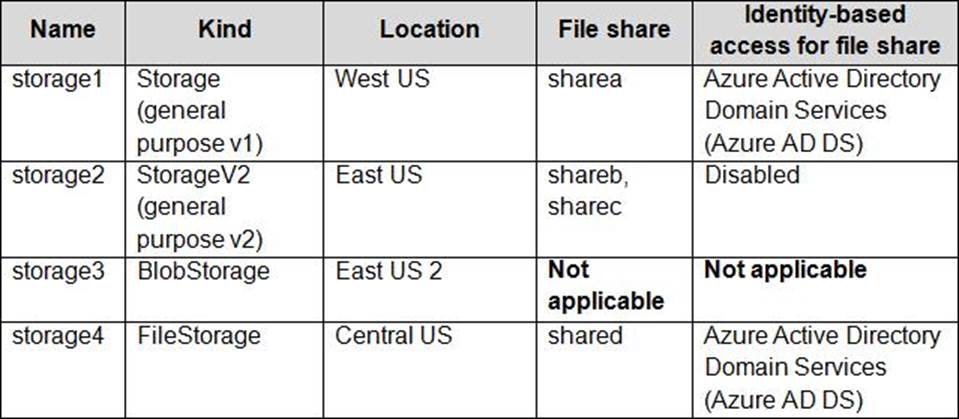
Requirements
Planned Changes
Contoso plans to implement the following changes:
✑ Create a blob container named container1 and a file share named share1 that will use the Cool storage tier.
✑ Create a storage account named storage5 and configure storage replication for the Blob service.
✑ Create an NSG named NSG1 that will have the custom inbound security rules shown in the following table.

✑ Associate NSG1 to the network interface of VM1.
✑ Create an NSG named NSG2 that will have the custom outbound security rules shown in the following table.

✑ Associate NSG2 to VNET1/Subnet2.
Technical Requirements
Contoso must meet the following technical requirements:
✑ Create container1 and share1.
✑ Use the principle of least privilege.
✑ Create an Azure AD security group named Group4.
✑ Back up the Azure file shares and virtual machines by using Azure Backup.
✑ Trigger an alert if VM1 or VM2 has less than 20 GB of free space on volume C.
✑ Enable User1 to create Azure policy definitions and User2 to assign Azure policies to RG1.
✑ Create an internal Basic Azure Load Balancer named LB1 and connect the load balancer to VNET1/Subnet1
✑ Enable flow logging for IP traffic from VM5 and retain the flow logs for a period of eight months.
✑ Whenever possible, grant Group4 Azure role-based access control (Azure RBAC) read-only permissions to the Azure file shares.
HOTSPOT
You need to create container1 and share1.
Which storage accounts should you use for each resource? To answer, select the appropriate options in the answer area. NOTE: Each correct selection is worth one point.
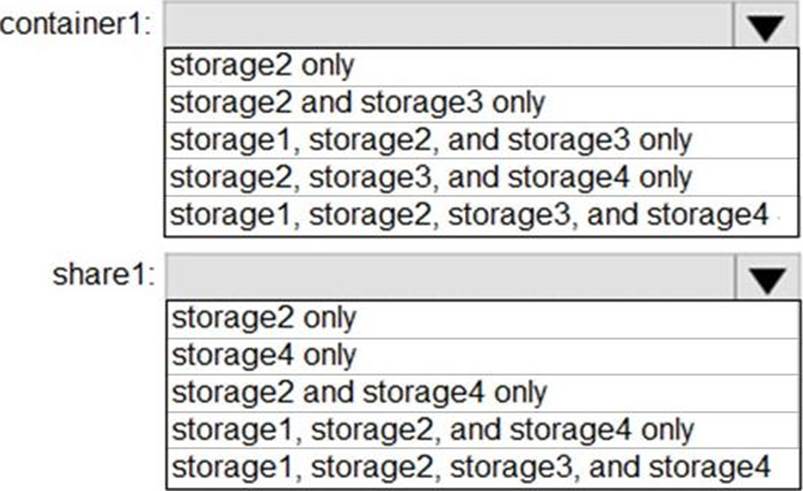
You need to identify which storage account to use for the flow logging of IP traffic from VM5. The solution must meet the retention requirements.
Which storage account should you identify?
- A . storage4
- B . storage1
- C . storage2
- D . storage3
Note: This question is part of a series of questions that present the same scenario. Each question in the series contains a unique solution that might meet the stated goals. Some question sets might have more than one correct solution, while others might not have a correct solution.
After you answer a question in this section, you will NOT be able to return to it. As a result, these questions will not appear in the review screen.
You manage a virtual network named VNet1 that is hosted in the West US Azure region.
VNet1 hosts two virtual machines named VM1 and VM2 that run Windows Server.
You need to inspect all the network traffic from VM1 to VM2 for a period of three hours.
Solution: From Performance Monitor, you create a Data Collector Set (DCS).
Does this meet the goal?
- A . Yes
- B . No
HOTSPOT
You have an Azure subscription that contains the container images shown in the following table.
![]()
You plan to use the following services:
• Azure Container Instances
• Azure Container Apps
• Azure App Service
In which services can you run the images? To answer, select the options in the answer area. NOTE: Each correct answer is worth one point.
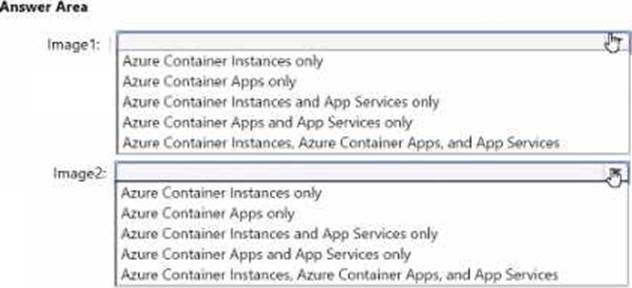
You have a Recovery Services vault named RSV1. RSV1 has a backup policy that retains instant snapshots for five days and daily backup for 14 days.
RSV1 performs daily backups of VM1. VM1 hosts a static website that was updated eight days ago.
You need to recover VM1 to a point eight days ago. The solution must minimize downtime.
What should you do first?
- A . Deallocate VM1.
- B . Restore VM1 by using the Replace existing restore configuration option.
- C . Delete VM1.
- D . Restore VM1 by using the Create new restore configuration option.


